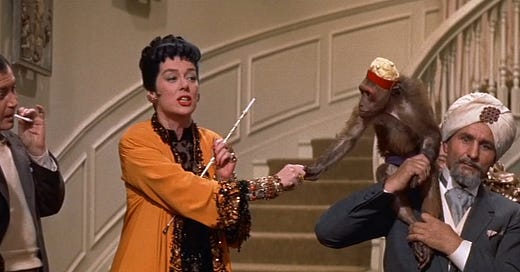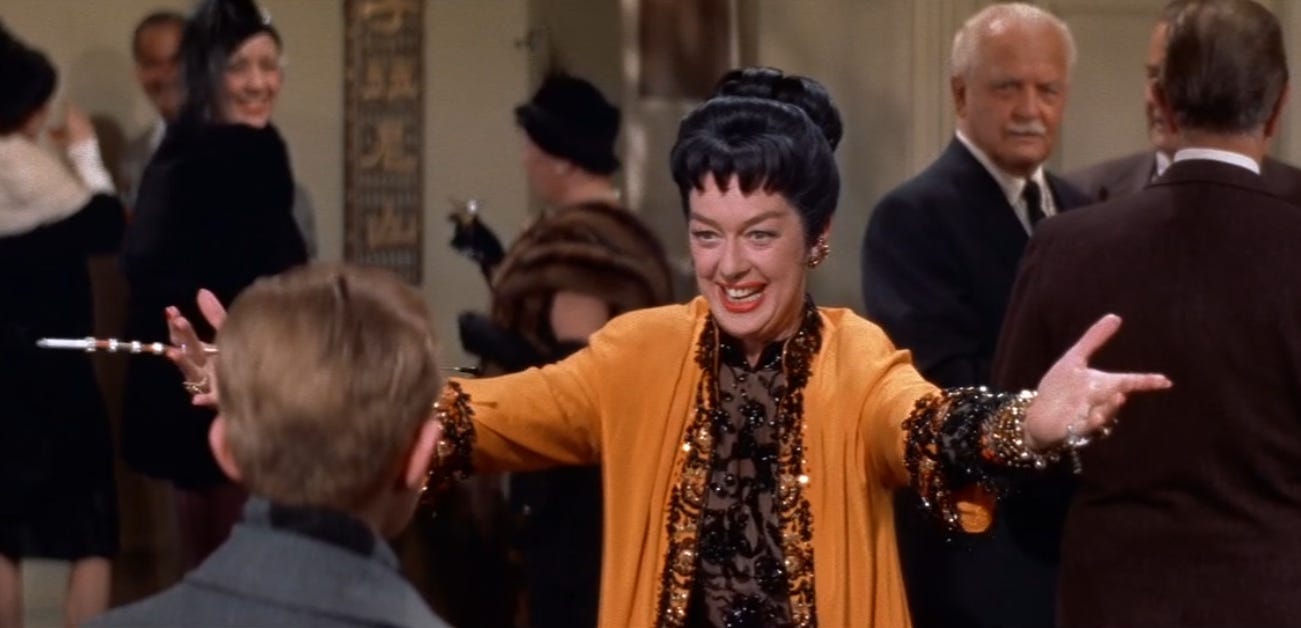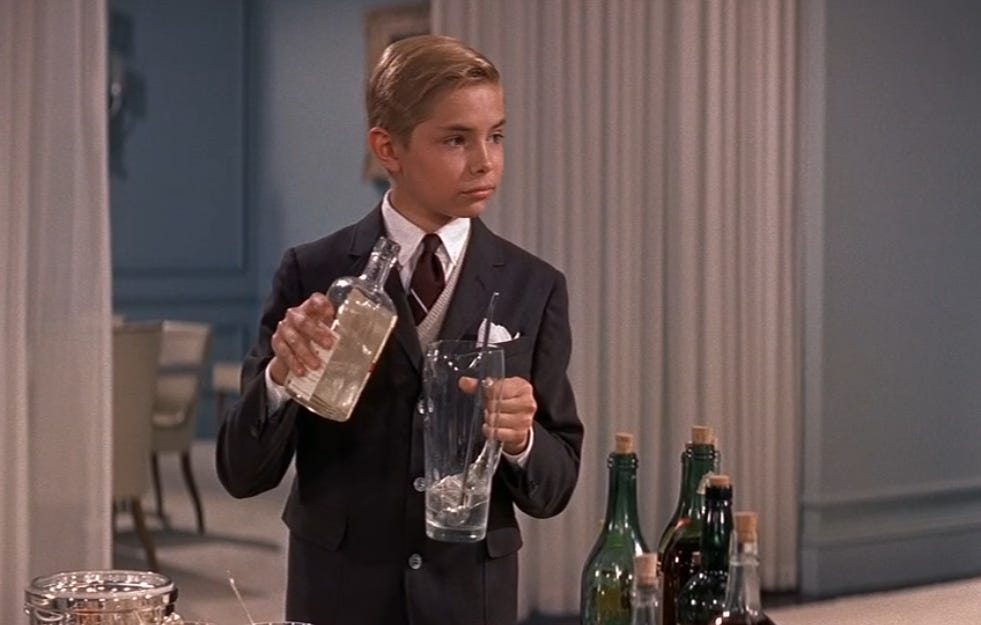I was 10 years old when I saw Auntie Mame at Radio City Music Hall, roughly the same age as Patrick in the film.
Together, Patrick and I passed through the dragon-embossed door of Beekman Place and stepped into a whirling party in progress:
Everyone with lopsided cocktails in hand, the women in hats and furs, a Gertrude and Alice couple in man-ties and fedoras, diplomats and financiers and actors and artists and Acacius the Greenwich Village philosopher-and-teacher-in-the-nude talking arty rot in weighty non-sequiturs, while behind him, past the balcony, a magnificent vista, the East River, ebony black, spanned by an enormous bridge twinkling with lights.
Suddenly, a bolt of orange in a black Chinese wig with artichoke bangs, running down the stairs, gabbing and grabbing and greeting, and in the madness, a divine accident, a monkey reaches out and she thrillingly shakes his paw!
And when the declaration comes, “But darling… I’m your Auntie Mame!” we are changed forever, myself and all the young kids who recognized in young Patrick our proxy. Claimed by the vivid zest of it all. Years and multiple viewings later, we still become in her madcap presence once again and quite gloriously wide-eyed, open-hearted boys.
Fast Facts:
Auntie Mame has the kind of Roaring 20s stock-market money that allows her to change the decor of her duplex with her mood. The Chinese exotica of the whirling party fades to a glamorous Hollywood take on Modernism with abstract paintings that may or may not be hanging upside down.
Later this is replaced by an ethereal dreamscape, with twisty white linen looping in garlands down the staircase and calla lilies everywhere. Best-friend Vera remarks “It looks like the main chapel of a funeral parlor,” which it does, to suit Mame, who for a few moments is in very glammed-out, backless-dress mourning. Next Mame decides to write her multi-volume memoirs (“boxed like Proust!”), and so the walls tower with decorative, color-coordinated books bought by the ton, and the interior palette turns a russet brown with busts of Shakespeare on pedestals.
Finally, Mame is back to her first love: inscrutable, experimental modern art, accented with fluid organic shapes, where the modular benches fly up on ropes and the mobiles smack characters in the head, the brainchild of the artist Yul Ulu —a name fans like myself delight in saying as much as the actors.“Child, how can you see with all that light?” Auntie Mame is waking at noon, and Patrick has opened the blinds. With the urbane sophistication that allows her to be magnificently candid, she declares her default condition. “Please, darling, your Auntie Mame is hung.”
“What the hell have you got back there…reindeer!” Vera is being upstaged by the jingle-jangle of Mame’s dangling bracelets, which is nothing compared to the entrance Mame makes, striding past the seething Vera, trailing gales of high-decibel stage laughter and boisterous, unwanted ad-libs, “Oh, Lord Dudley, no more champagne or I shall forget myself,” drowning out Vera’s lines, waking up the bored audience with something approaching delight at the obvious transgression, and all in all, being Mame Dennis at full strength.
Like the fairy godmother in Cinderella, Mame bibbidi-bobbidi-boos the mousey Miss Gooch into … well, a woman in a strapless gown, that Gooch in her unspoiled Doctor-Pepper-drinking way, fusses with, needing constantly to pull up the bodice.
And now, here it comes! In one immoral outburst, the most famous, most quoted dialogue in the film, Mame declares her credo to her timid secretary… and to all the people of the world: “Oh Agnes, where is your spine! Here you’ve been taking my dictation for weeks, and you don’t get the message of my book: LIVE! That’s the message! Life is a banquet and most poor suckers are starving. LIVE!, Agnes LIVE! LIVE! LIVE!
Finally, there’s a special magic Auntie Mame has for gay men, and a lot of it has to do with the effete-looking young actor who plays Patrick, perfectly cast as a mannered, overly polite boy. Let’s examine this magic.
Auntie Mame is the seductive mother, but the mother without guilt, because she's the aunt, who has replaced the forbidden mother. She is madcap and fun, the way aunts can be… aunts not being tasked with the serious work of molding responsible, employable adults.
Auntie Mame is a flirt with men, just as the budding gay boy in the proxy of Patrick is beginning to feel the power dynamics sparking between men and women, particularly the blinding effect beauty has on men. So Auntie Mame is the perfect devotional figure for gay boys, and for the men they become — part role model, part gal pal.
The bond between Auntie Mame and her nephew is intense precisely because she brings Patrick up without a husband — they are a fun couple onto themselves, and they love each other. Then the Depression wipes Mame out, and the plantation millionaire Beau drops into her life (soon to drop off an Alpine crag… conveniently).
By then Patrick has grown old enough to “wear long pants,” (a rite of passage in Waspy mid-century films.) Presto chango, he soon appears as a college freshman, played by a dreamy Roger Smith, who is quite matey and guy-guy — and the gay proxy ends. This is not the true trajectory for young Patrick, with his particular ways and soulmate-confidant relation to his aunt. To the sensitive viewer, the switch in actors is as disruptive as if young Patrick had fallen asleep in Invasion of the Body Snatchers and awakened as a heterosexual.*
Gloria Upson is the punishment for this transformation. Like Miss Gooch, Gloria, with her lockjaw upper-upper-class diction, is one of the enduring joys of the film, immortal for the line “And I stepped… on the ping-pong ball!” Hand flying to her pearl necklace to stem the momentous hilarity of it all, getting only blank expressions, trying to underscore the point. “Well, it was ghaastly… well, it was just ghaastly!”
Another wonderful moment occurs at the dinner party thrown for the Upsons, where they are settled on the flying benches that go up and down when Mame pulls the cords: A servant is passing around the hors d'oeuvres. “Oh Moms,” cries Gloria, “try one of the stripe-ed ones.” Moms does. “What is it, Mamie?” Mame, who does not take kindly to being called “Mamie,” who remembers being served tuna fish and peanut butter passed through the meat grinder and daiquiris oversweetened with honey when she visited the Upsons, replies “Oh, just plain old pickled rattlesnake.” Saying it with cheery élan and not a hint of revenge.
Of course, Mame comes to the rescue of this imposter Patrick, saves him from a stifling marriage as an upper-upper-class “Aryan from Darien,” shepherds him to a better match with an art girl, and appears in the last scene, guiding their 10-year-old son, whom she has dressed in a gold turban to match her gold sari, climbing the stair of her duplex, now awash in golden-sunset Indian decor, enchanting the boy as she once enchanted his father… and all the rest of us:
“Your Auntie Mame is going to open doors for you, Patrick… doors you never even dreamed existed”
Screencaps, via YouTube1 and YouTube2: Auntie Mame, 1958, Warner Bros.
DVD available on Amazon.
*Meanwhile, the actor who played the effete young Patrick, Jan Handzlik, grew up to have two wives, six children, and a career as a federal prosecutor. File under: Stranger Than Fiction.
Yours truly,








